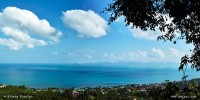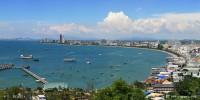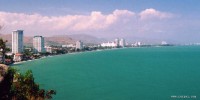Riding & Renting Motorbikes in Thailand
Now well into the 21st century, motorbikes remain the most popular form of transportation within the kingdom of Thailand. The average cost of a brand new motorbike is anywhere from 30,000-60,000 Thai Baht or more, depending on the size of the engine and other optional upgrades. The RaiYai team has gathered some useful information and tips for riding, renting, and dealing with motorbikes in Thailand, so do yourself a favor and read on!
Rental prices: Car and motorbike rentals are a big business in Thailand, and choosing a reputable rental shop is important. Generally, shopping for a motorbike rental in a crowded tourist area is not the best idea, as the prices will be higher and the shop owners often trickier. A better idea is to ask the hotel or apartment you are staying at for a recommendation, or search on Google for a shop owner who offers stable pricing and friendly customer service. Prices should usually be between 150-250 baht per day, depending on the region. For monthly rentals, you can usually barter down to around 3,000 or even 2,500 baht if you are lucky and the shop owner trusts you (easier if you bring a Thai friend). Good signs to look for: motorbikes that have been recently washed, tires that have good tread left on them, polite shop owners who are willing to offer you a deal for longer periods, and so forth.
Motorbike manufacturers: Most newer motorbikes in Thailand are designed either by Honda or Yamaha. Both companies are extremely well known and manufacture reliable motorbikes. However, there are some differences. For example, the turn signals on Honda are a toggle design, while on Yamaha they are a click-unclick design. The mirrors are also shaped and angled differently, along with the seat cushions. Yamaha tends to implement cup holders on all of their newer bikes, along with a “turn to unlock” feature on the key ignition for opening the seat cover (and underlying gas cap). In general, Yamaha seems to have more user-friendly features across all their motorbikes, whereas Honda tends to strip down their cheaper models more.
Engine sizes: If possible, try to get a motorbike with at least a 125cc or 135cc engine, especially if you are riding around Phuket, Koh Chang, Chiang Rai, or other areas in Thailand filled with steep driveways and mountains. Simply put, a stronger engine keeps you safer by allowing you to quickly climb a hill without stopping, or by helping you get away from a crowd of obnoxious teenagers blocking the road.
Note: many foreigners who visit Thailand and approach rental shops in “popular” areas may be pushed to rent high-powered street motorcycles, such as Kawasaki, or the yakuza motorbikes, which are over-sized cruiser models. This is a bad idea for multiple reasons. Firstly, these shops are sometimes known to invent fake problems with the bikes upon customers returning them, in order to charge exorbitant fees to “fix” the bike. Furthermore, while it may be temping to look cooler than other tourists by renting one of these, it in fact will make you stand out like a sore thumb! In general, mostly Russians and Scandinavians are the ones who rent these types of motorcycles, and sadly, they are well-known around Thailand to crash them as well.
Gasoline (petrol): Most of the motorbikes in Thailand require “91” gasoline, referring to the octane content, which is always yellow in color. Some bikes will require or be recommended to use “95” gasoline, which is always dark orange in color. There are a few other types of fuel in Thailand such as gasohol and other “eco-friendly” mixes, but these are rarely designed for motorbikes and in most cases, 91 gasoline should take care of your needs.
Note: Almost everywhere in Thailand you can find roadside bottles of gas for sale, usually around 40 or 50 baht per bottle. These over-priced bottles are sold by private shop owners, mostly in the case of emergencies, or in areas where there are no gas stations nearby. It is always a better idea to fill up your gas tank at an established gas station in order to save money and ensure the quality of the petroleum is higher.
Locking motorbikes: It is important that you figure out how to lock the front wheel of your motorbike the first time you ride it. Too often, thieves around Thailand steal motorbikes that are not properly locked, easily rolling the bike down the street and throwing it into a truck or otherwise. Locking your front wheel, either by a simple key ignition method (on newer models) or a traditional wheel lock, is essential when parking your bike overnight or in less-than-trustworthy areas.
Helmet usage: The use of helmets while riding motorbikes in Thailand is extremely recommended. While the police in most of the larger cities love to use it as an excuse for fining tourists, the truth is that is really is for your own safety. Rather than grabbing the half-broken helmet you may be offered for free by a rental shop, it is a better idea to purchase (or borrow) a high quality (expensive) motorcycle helmet that fully covers your head and neck. These are the only helmets that have actually been proven to drastically improve your safety – and with the high risk of traffic accidents throughout Thailand, don’t risk ignoring this factor.












